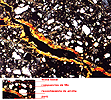
Apart from the physical disintegration and chemical alteration processes, there is a third process that has an extremely important action on the formation of soil and that is the translocation of substances, which on the one hand mixes and adds the edaphic materials and on the other separates and concentrates them. All these actions are carried out either by soil organisms, especially those that excavate galleries, such as worms and ants, or by a simple mechanical effect, very often due to the action of water transporting materials, sometimes in suspension and sometimes in dissolution. This dragging by the action of water has very important effects on the soil and can eliminate the substances transported from the profile or accumulate them at a certain depth.
Translocation of substances can also be demonstrated
easily on a microscopic level seeing how certain materials cover
the walls of voids or even completely fill in cracks in the soil.

The following two images show a microscopic field of a soil with a crack scoring it. The walls of the crack are covered by a yellow clay coating and the lower part of the void's walls are impregnated with a black material. As both materials are related to the crack and they do not exist in the rest of the soil, it seems correct to accept that it is a case of materials that have been moved through the void.


The yellow material coats the void's walls, while the black colour impregnates and becomes diffused through the walls. Why? The yellow material is clays that have migrated in suspension and as they accumulated, they were not able to cross the void's walls, whilst the black material is Mn compounds that have migrated as solutions and have therefore entered in the soil mass through the walls.
Finally, we need to clarify which one was deposited first: the clays or the Mn compounds? If the clays had been deposited first, the Mn compounds would have impregnated the clays.
The translocation process of materials in the
soil is very complex affecting very different substances (minerals,
organic matter and complex organic minerals, whether they are
solutions or suspensions) and for very different reasons (gravity,
capillarity, evaporation, biotic activity, or as a consequence
of the soil mass swelling and contracting).